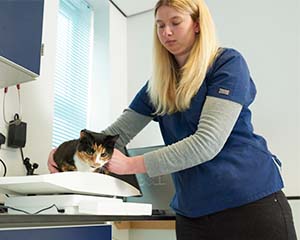06 October 2017
85% of vets report that either they or a member of their team have felt intimidated by a client's language or behaviour, prompting British Veterinary Association (BVA) and British Veterinary Nursing Association (BVNA) to offer advice on dealing with this issue this National Work Life Week.
Veterinary teams are experiencing a high level of intimidation from clients bringing their animals into practices across the UK, according to the survey of more than 1,600 BVA members. While around half of vets have felt threatened by their clients' actions or language many vets commented that support staff such as receptionists often bear the brunt of threatening behaviour.
Those vets who work with companion animals or in a mixed practice are particularly likely to have experienced difficult clients with 89% reporting some form of intimidating experience. Younger vets and female vets were significantly more likely to have experienced some form of intimidation.
BVA's survey revealed that animal owners' intimidating language and behaviour is often related to the cost of treatment, with 98% of vets saying that at some time they feel under pressure from clients to waive fees or to accept the promise of late payment.
President of the British Veterinary Nursing Association, Sam Morgan said: “These statistics make for sad reading, but are certainly not surprising. Working within practice we have all either been subject to or witnessed that ‘difficult' client. We understand there can be a lot of distress when pets are ill, but this is no excuse to be aggressive or intimidating to a member of the veterinary team. It's important not to feel alone in these situations and to ensure there is awareness and support throughout the veterinary team.”
President of the British Veterinary Association, John Fishwick, said: “Every situation is different and has to be dealt with on an individual basis, but it's concerning to see the figures around challenging client behaviour and fees. Owning an animal is an important responsibility and will cost tens of thousands of pounds over its lifetime. It's important for everyone in the vet team to take pride in the healthcare and treatment they deliver, and, equally, they must feel valued for their services. These figures emphasise the importance of managing expectations around fees by ensuring a two-way discussion about options and costs so clients can make a decision in collaboration with the veterinary team.”
In a week that highlights well-being at work and work-life balance BVA and BVNA have worked together to provide some advice on how to deal with intimidating clients, as one of the two organisations' first actions of collaborative working under their new Memorandum of Understanding.
Advice to deal with intimidating clients:
- Try to remain calm, at all times; be confident but never aggressive.
- Personal safety for the veterinary team is the highest priority. If you feel intimidated by a client, try to not be alone with them. If you do not feel able to resolve the immediate scenario and you are concerned about your safety then politely ask the client to leave. If you see other team members facing difficult clients, do not leave them alone, remain within sight so you can go and get more help or step in and support your colleague.
- Although easier said than done, try not to take it personally. If you are on the receiving end of this behaviour, it can be upsetting and a cause of significant stress
- Always discuss with your colleagues any difficult situation you have encountered with a client. Consider how well you handled the situation: what did you do well, what could you have done better, what was the final outcome. Think about what you have learnt and use it when you next encounter a difficult client and learn from each other. Work together to have a practice policy on how to deal with intimidating situations
- Remember to inform the practice manager or practice principal so that appropriate practice level steps can be taken.
- Use clear messaging within the practice that harassment and violence will not be tolerated. Clients should be made aware of what unacceptable behaviour means.
- Remember that people's behaviour can arise for many different reasons, including distress associated with their pet being ill. While not excusing the behaviour, it can help to diffuse a situation if the owner can have the opportunity to get all their concerns out. This can be done by active listening attentively and ensuring the client knows you have heard by reflecting these concerns back to them. Clients may also need to be reassured that ‘they've made the right decision' or ‘we're doing everything we can', or even checking with the owner that they understand everything you've told them or ask them if they have any questions they'd like to ask.
- Consider attending training courses on understanding and dealing with these types of situations to help you and your clients.



